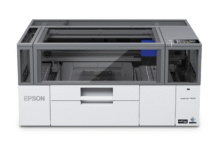The results of a series of lab experiments demonstrate why Xaar’s TF technology ink recirculation, invented some years ago, still sets the benchmark for industrial inkjet recirculation techniques today to deliver a wider window of operation for users. Presented in Xaar’s new white paper subtitled ‘What goes around, comes around,’ the research compares Xaar’s TF technology ink recirculation with alternative ink recirculation techniques used by most other printhead manufacturers.
Whilst ink recirculation is now commonplace, the white paper clearly shows that all technologies are not equal. A printhead’s architecture determines how well ink recirculation is implemented and therefore influences the degree to which the method delivers benefits across today’s wide range of printing and jetting applications.
TF technology is a key building block in Xaar’s recently announced ImagineX bulk platform, which will power the next 30 years of innovation in inkjet capabilities and printhead launches.
Together with the unique Hybrid Side Shooter printhead architecture, Xaar’s TF technology enables ink or other fluids to flow directly past the back of the nozzle during drop ejection at very high flow rates.
This ensures the nozzles are continuously primed, keeping the printhead operational, and the nozzles firing and – with the ink in constant motion – prevents sedimentation and nozzle blocking, particularly in heavily pigmented inks. Any air bubbles and unwanted particles in the ink are also carried away, improving reliability, even in the harshest industrial environment.
With TF technology, jetting is significantly more reliable compared to alternative ‘roof mode architecture’ design printheads whose convoluted ink flow paths means that recirculation is close to but not at the back of the nozzle.
“Xaar’s TF technology ink recirculation completely revolutionized inkjet printing and has become an essential feature for a wide range of industrial inkjet applications,” said Angus Condie, director of Technology at Xaar and one of the authors of the white paper.
Launched by Xaar in 2007 with the introduction of the Xaar 1001 printhead XF Technology has since opened up exciting new applications such as glass printing with frit inks, high opacity white pigment ink printing for labels, and heavily loaded conductive inks for printed electronics – transforming the digital inkjet industry and becoming an industry requirement for effective and reliable inkjet printing.
“Our research proves that ink recirculation solutions vary due to their architectural design, yielding vastly different results. Xaar’s TF technology still greatly outperforms its rivals and continues to set the benchmark for ink recirculation today, delivering the widest window of operation within inkjet printing,” concluded Condie.
The complete white paper can be downloaded here
















